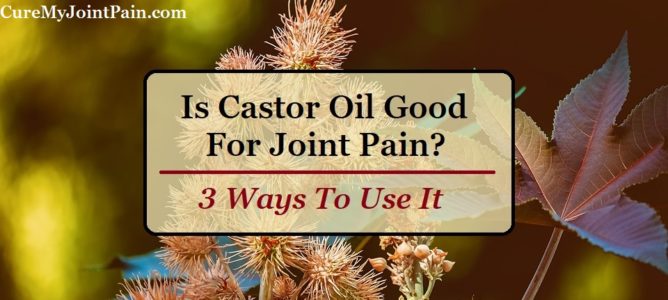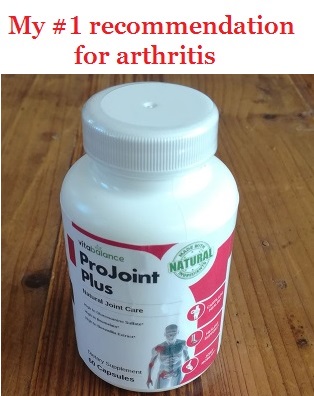Is Castor Oil Good For Joint Pain? 3 Ways To Use It

You surely heard and even used castor oil at least once. It’s a great treatment for hair, skin and a lot of other condition. But what about arthritis? Is castor oil good for joint pain?
Though it may be surprising, it seems that this oil has can help unhealthy joints. Don’t imagine it’s a miracle-maker, but it can help your arthritis if you have patience. However, the #1 problem is that you have to use it for months before you notice any slight improvement.
So how exactly can castor oil improve joint pain? I did a deep research and here’s what I found about it.
Note: Castor oil is a herbal remedy and it will most likely not cure your pain. It can help, but don’t expect it to do miracles. If you want to get a real improvement and treat the cause of your pain, I recommend you natural supplements because they are a lot stronger.
What’s Inside Castor Oil?
If this oil is really effective for joint pain, it must be because of the substances it has inside. At first sight, there’s nothing impressive.

It contains lots of different compounds, but there’s only one that stands out. Obviously, that’s because it has the highest percent. I’m talking about ricinoleic acid, which can’t be found in a lot of other plants.
As it’s an unsaturated fatty acid, ricinoleic acid is great for swelling. It manages to fight back inflammation, so that’s why it’s a great match for swollen joints.
On the other hand, ricinoleic oil also protects the body, creating antibodies for toxins and pathogens. However, you can usually get this benefit if you take castor oil orally, which I wouldn’t really recommend. At least not for joint problems.
So that’s what you basically have to keep in mind about castor oil. It’s effective in arthritis and joint pain because of the ricinoleic acid it contains, which is an anti-inflammatory.
By Mouth Or On The Skin?
That’s one of the major things when it comes to castor oil. Okay, so we know that it can help joint pain, but how exactly should we use it? A lot of people asked me this question, and I have a pretty straightforward answer.
- If you only have joint pain, don’t take castor oil by mouth
First of all, it won’t help your joints. The biggest part of it will be absorbed or eliminated pretty fast, so only a very small percent will get to your joints.
But there’s one major reason why I don’t recommend you to take it by mouth. Castor oil is used as a laxative, you probably heard that before. Lot of herbal laxative supplements contain it, because it has a pretty strong effect. So if you took it by mouth, it would surely produce you diarrhea.
That’s why I would never recommend taking castor oil orally. If your doctor recommends it, that’s totally fine. But make sure you get his consent before you use it orally.
- So if you only have joint pain, use castor oil topically
That’s the best way to get its anti-inflammatory effect. What’s interesting is that castor oil is pretty thick, compared to other oils. So it doesn’t get absorbed through the skin almost at all.
For this reason, you would have to apply it on the skin, massage for a couple of minutes and then use a towel to take it off. You can leave it on for a long time and it still won’t get absorbed, so it’s not worth trying.
Best 4 Ways To Use It
Maybe I’m not saying something new at this point, as most of you would know how to apply castor oil on your skin. But after doing a deep research, I found out several recipes (if I may call them like this) that seemed to work a lot better.
So simply applying castor oil on your skin is not wrong. But you probably won’t get the most of its benefits in this way. That’s why I recommend you to follow one of these 3 recipes that I found, because they seem a lot more effective. Is it just me who thinks that?
1. Warm Massage
As I said, simply applying castor oil on your painful joint isn’t enough. It might help, but the effect could be a lot better if you changed a few basic things.

The warm massage is probably the easiest out of these 4 recipes, because anyone can do it at any time. You don’t need any other ingredients than the regular castor oil, which you can find in most stores. In my opinion, you don’t necessarily need an organic brand for the massage.
If the bottle you have is organic, it’s great, but it’s not a must.
How Exactly You Should Do It: Add some castor oil in a bowl and put it in the microwave until it’s warm. Make sure it’s not too hot, because it won’t be too pleasant. Warm is totally fine.
Add some of the oil on and around your painful joint, and start massaging slowly. You can increase the intensity of your massage, but make sure you do it slowly. Do it for about 5 minutes (or more if you can) and then take off the oil using a towel. Castor oil won’t soak in, so there’s no point letting it sit for longer. It won’t get absorbed completely even in 10 days.
You can do this warm massage for several days in a row or anytime your joints are in pain. It won’t do any miracles, but it could bring some relief.
2. Heat + Oil Pack
That’s a pretty original recipe, as I haven’t heard about it before in any oil. But in my opinion, it should be really effective. That’s because it combines the benefits of castor oil with heat, which is a great helper in arthritis.
You can use either a heating pad or a regular towel, that would would soak in hot water. I think it’s easier to do it with a heating pad, but if you don’t have one, you can use the second option.
How Exactly You Should Do It: Place a clean towel under the heating pad for a while and then add a few drops of warm castor oil on the towel. Don’t add to much and make sure it’s not dripping out. If you don’t have a heating pad, put the cloth in hot water, squeeze it and then add the castor oil.
Now you can simply put the towel on your painful joint. You can either hold it there using your hands, or wrap something around it so that it stays in place. I read about cellophane, but I think it’s too complicated, so I would just use my hands.
You should keep this pack for at least half an hour, but the more, the better.
3. Soaked In Pack
This is probably my favorite method out of these 4, because it seems like the most comfortable on. It might be a bit messy in the end, but I believe it’s worth the derangement.

How Exactly You Should Do It: Warm up about a bowl of castor oil in the microwave. Use a flannel or an old cloth and soak it all in the warm castor oil. I would recommend leaving it for 5-10 minutes, so that the fabric is soaked in completely.
Once you do this, put the flannel on your painful joint and let it sit for several minutes. You could place a towel under, so that the oil doesn’t drip on the floor.
Don’t expect to feel a change in your pain immediately, because you won’t. Simply let it sit for a while and you might notice that your pain is not as strong as before.
But as I said, you might not see the results from the start. Sometimes you need to apply this soaked in pack for several days in a row to see an improvement. It all depends from person to person, so who knows? After all, you’re not losing anything trying it. And in my opinion, it’s worth all the mess.
My Final Verdict – Is Castor Oil Worth Trying?
Short answer: Definitely. It probably won’t help you tremendously, but it’s a natural remedy after all. So you’re not losing anything trying it.
I’m not a personal fan of oil rubs and packs, but I know they can really help. Besides, there are some persons that can really see a change. I’m not one of those, but I can’t criticize castor or any other oils. When it comes to this one, it has what it needs to relieve the pain – the ricinoleic acid inside is a great anti-inflammatory.
As I said, it’s a natural remedy, and it’s not the strongest one for inflammation. For this reason, it will probably not make miracles, nor relieve your pain completely even if you use it for 10 years. But it could decrease some of your pain, or help your joint stiffness.
So I pretty much recommend castor oil. As I said, you’re not losing anything trying it. Maybe just a couple of dollars, but you would buy it either way for hair (I know a lot of people use it for hair growth). So I think it’s worth giving a shot.




